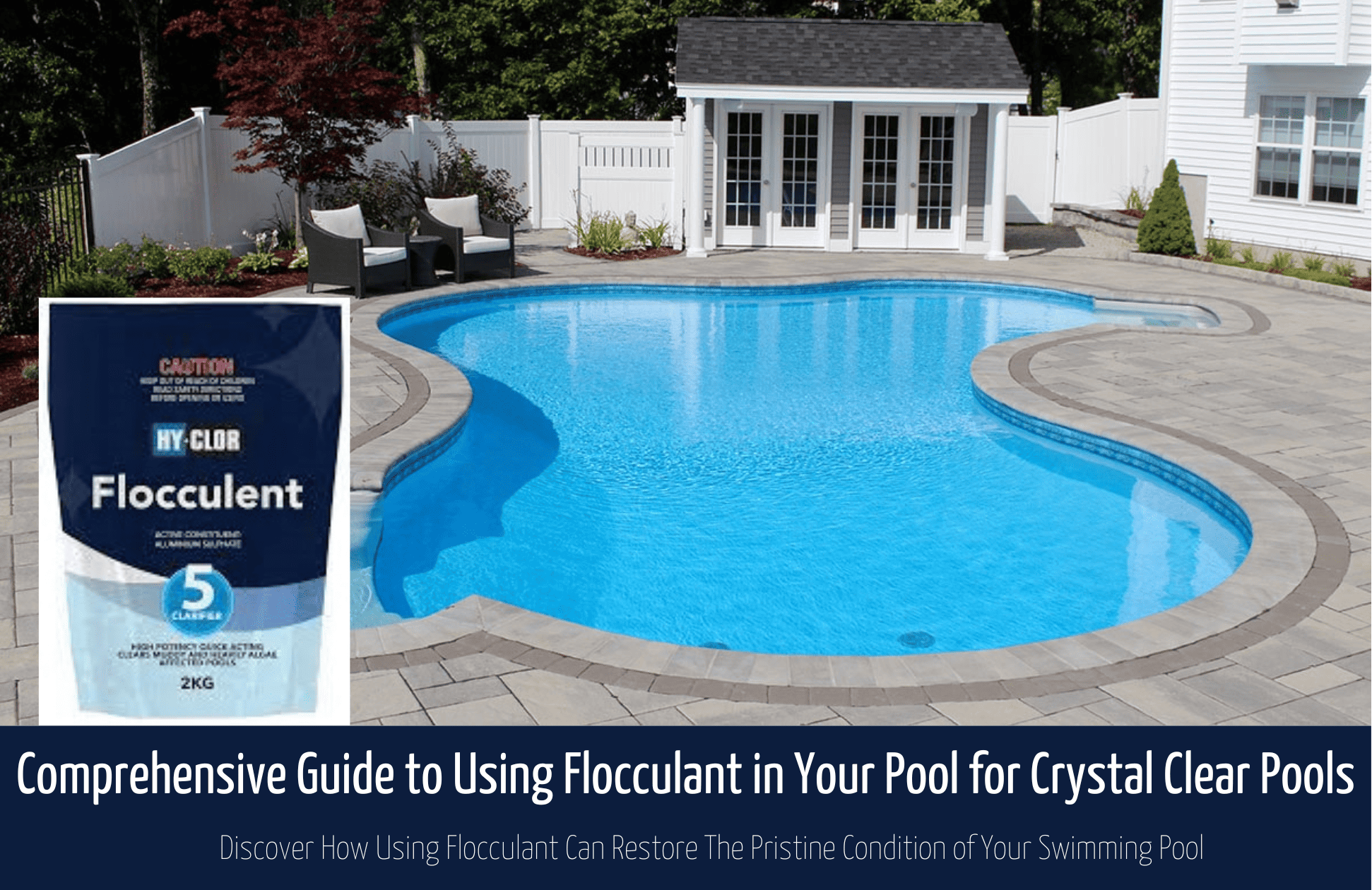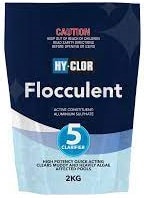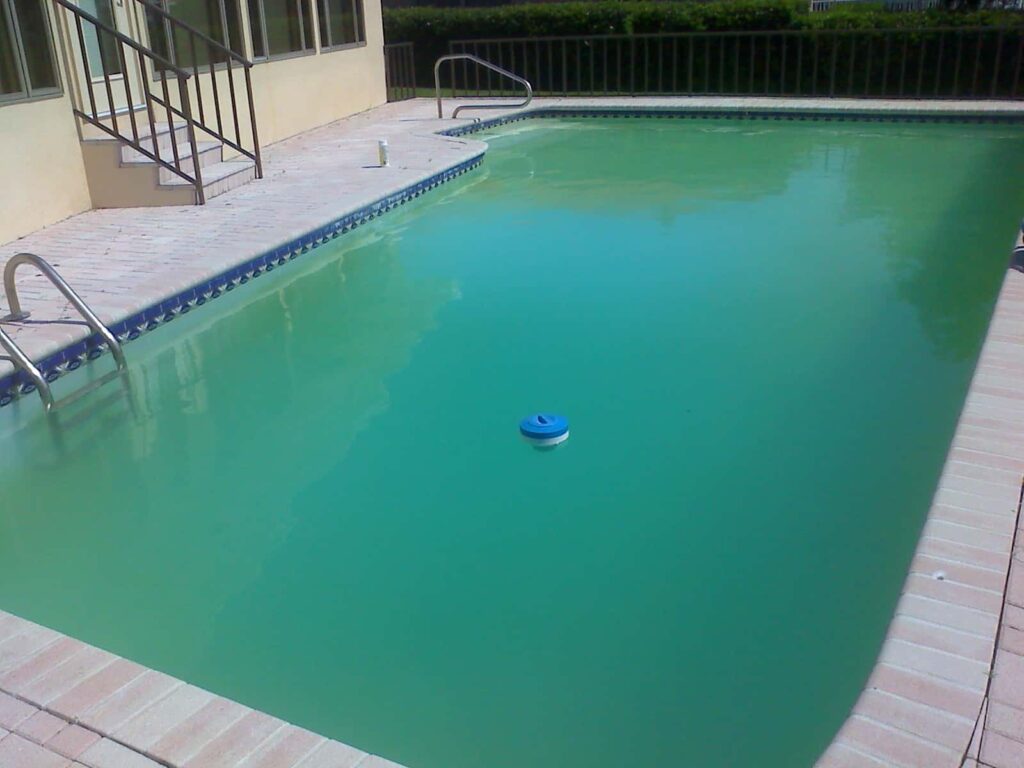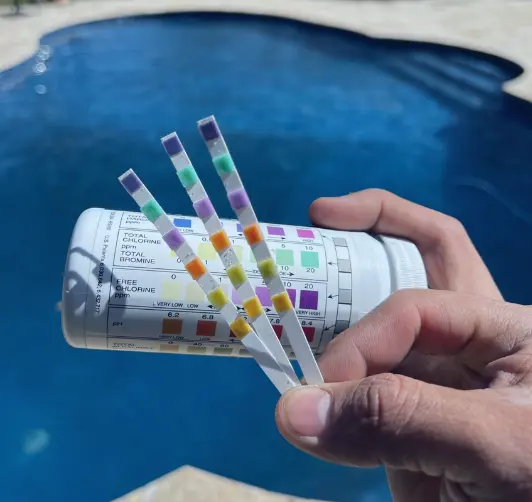
If you’re a pool owner, you’re likely familiar with the challenges of maintaining your pool’s pristine condition.
One of the most common issues we encounter is the persistent cloudiness and stubborn dirt that can often reduce the inviting clarity of a pool.

These impurities can linger in your pool despite regular cleaning, making your pool look less appealing and unwelcoming.
A key factor contributing to the pool’s cloudiness and diminished water quality is the presence of Total Dissolved Solids (TDS).
TDS refers to the combined concentration of various dissolved substances in the water, including minerals, salts, metals, and other organic compounds.
But worry not; we have a solution to address this issue effectively – using a pool flocculant.
Flocculants are chemical compounds that can clear your pool by aggregating these fine, dispersed particles into larger clumps, which sink to the bottom of your pool for easy removal.
This process is a highly effective way to tackle the issues of cloudiness and dirt that often plague our swimming pools.
In this article, we’ll be diving deep into the world of flocculants. We will provide you a brief understanding of what they are, when to use them, and most importantly, a detailed, step-by-step guide on how to use them in your pool.
So, whether you’re a seasoned pool owner looking for a more effective way to keep your pool clear or new to pool ownership and seeking insights into maintaining your pool, this post is tailored just for you.
Let’s dive in and uncover the secrets to achieving that perfect, crystal-clear pool water we all love.
Let’s start with the basics – what exactly is a flocculant?

In the simplest terms, a flocculant is a chemical compound that aids in the clarification of water. It’s a vital player in pool maintenance and an indispensable tool for many pool service professionals like us.
But how does a flocculant work?
It’s all about the science of particles. On a molecular level, flocculants work by attracting fine particles that are suspended in your pool water.
These particles, which are typically responsible for the cloudiness of the water, are too small to be filtered out by most pool filtration systems.
When a flocculant is added to the water, it binds these tiny particles together to form larger clumps, or “flocs,”
These larger lumps are heavy enough to sink to the bottom of the pool, making it possible to remove them using a pool vacuum.
Flocculants are very effective for tackling murky or cloudy water – a common issue for many pool owners. Flocculants can bind these particles together to improve the water clarity dramatically, Whether due to an influx of fine dust, pollen, algae spores, or other contaminants.
Furthermore, in the aftermath of a pool party or following a heavy storm, where a high level of debris might be present, a flocculant can be a game-changer in your cleaning process.
However, it’s essential to remember that flocculants aren’t a one-size-fits-all solution for all pool issues.
They are not designed to replace the need for regular sanitization and filtration but to complement these processes when regular maintenance isn’t quite enough.
Understanding when and how to use flocculants will make them a powerful tool in your pool maintenance routine.
Let’s talk about when is the right time to use a flocculant.
Flocculants are not meant for daily use but are intended to rectify specific issues when your standard maintenance routine can’t quite cut it.
Ideal scenarios for using a flocculant arise when you notice that your pool water isn’t as clear as it should be, despite regular chlorination and filtration.

This may be due to fine, suspended particles that your pool’s filter system cannot remove. You might notice a murky appearance to the water or even a greyish or greenish hue – these are signs that a flocculant could help clear things up.
In addition, after a particularly busy pool day, especially those fun-filled pool parties, you might find your pool water has residual cloudiness.
This could be due to lotions, oils, or other residues from swimmers that your filter can’t quite handle.
In this case, applying a flocculant can work wonders in restoring your pool’s clarity and cleanliness.
Seasonal considerations also come into play. For instance, during the spring season, pollen can be a major contributor to cloudy pool water, and a flocculant can help bind this microscopic material together for easy removal.
After a storm or heavy rain, debris and other contaminants can enter the pool, making using a flocculant a quick and efficient way to restore water clarity.
Remember that using a flocculant is not a stand-alone solution but should be part of a comprehensive maintenance plan.
It’s always important to keep up with regular cleaning and maintenance tasks, such as checking and adjusting chemical levels, emptying skimmer baskets, and regularly cleaning or backwashing your filter system.
Now, let’s walk through the process of using a flocculant in your pool. We’ve simplified this process into five easy-to-follow steps.
But before we dive in, let’s start with the tools and materials you’ll need:
Now, let’s proceed to the steps:
Before adding any chemicals to your pool, testing your pool water is crucial.
This will ensure that your water chemistry is balanced, which is important for the flocculant to work effectively.

Use your pool test kit to measure and adjust the pH, alkalinity, and sanitizer levels.
Aim for a pH between 7.2 and 7.6 and an alkalinity level between 80-120 ppm.
Since we will be turning the pool pump off to allow the flocculant to work undisturbed, there is a potential risk of algae growth in the stagnant water. Don’t be afraid to over-chlorinate your pool at this time by adding enough shock to get the free chlorine to 20+ppm.
2. Applying the Flocculant
Follow the manufacturer’s instructions on your flocculant package for the correct dosage – usually, this will depend on the size of your pool.
Carefully add the flocculant to your pool, ensuring even distribution. This is easiest when the Multiport of your Filter is in “Recirculate” mode. You can put the flocculant directly into your skimmer and it will return to the pool through the return jets.
3. Letting the Pool Run in Recirculate
Keep the pool running in Recirculate for 2-6hrs (based on manufacturer’s instruction) to ensure the flocculant has evenly dispersed throughout the pool.
4. Turning Off the Pool Pump
Once the flocculant has been added and distributed, it’s time to turn off your pool pump.
This allows the flocculant to work undisturbed, binding the fine particles together without interrupting the pool’s circulation. This is very important as the water cannot be disturbed during this process. Do not turn on the pump, clean, add water or do anything that would move the pool water.
5. Allowing the Flocculant to Work
Patience is key here. Allow the flocculant to work its magic for at least 24-48hrs.
During this time, the flocculant will bind the fine particles together and cause them to sink to the bottom of your pool.
6. Vacuuming the Pool with a Power Vac
After giving the flocculant ample time to work, you’ll notice a significant difference in your pool’s appearance.
Now, it’s time to remove those settled particles from the bottom of your pool.
Using a pool vacuum or Power Vac, carefully vacuum the pool floor, ensuring that you collect all the coagulated particles.
However, if you don’t have the necessary equipment or are unsure about this process, our professional Power Vac service is here to help.
Our team of experts will ensure that all the coagulated particles are effectively removed from your pool, leaving it crystal clear and ready for use.
Congratulations! You’ve successfully used a flocculant to restore your pool’s clarity.
Remember, this process may need to be repeated for severe cloudiness, but with patience, practice, and our professional services available to assist, you’ll be a pro in no time.

Safety and effectiveness are our top priorities when it comes to pool maintenance. Review some safety guidelines and tips for handling and using flocculants in your pool.
These often overlooked components are essential to maintaining a strong seal and preventing leaks in your pool’s circulation system.
Damaged or worn gaskets can lead to inefficiencies and more significant issues. We carefully inspect all gaskets for signs of wear and tear to ensure they’re in peak condition.
Let’s explore the numerous benefits of incorporating a flocculant into your pool maintenance routine.
One of the most immediate and noticeable benefits of using a flocculant is improving your pool’s visual clarity.
A clear, sparkling pool is aesthetically pleasing and signals a clean and healthy swimming environment.
By binding together fine, suspended particles that often cloud the water, a flocculant can transform a murky pool into a clean, inviting pool.
You’re reducing the load on your filter by using a flocculant to deal with those fine particles that your pool’s filtration system struggles to handle.
This not only helps your filter perform more effectively, but it can also extend its lifespan by preventing clogging and reducing wear and tear.
This, in turn, can save you significant time and effort on maintenance in the long run.
Compared to other pool maintenance methods, such as continuous filtration or frequent backwashing, a flocculant can be highly cost-effective.
It’s a one-time treatment that targets specific problems, meaning you only need to use it when necessary, not as a daily regimen.
Furthermore, reducing the burden on your filtration system will likely save energy and potential repair or replacement costs.
To sum it up, using a flocculant is not just a solution to a cloudy pool – it’s a strategic decision that can enhance the overall operation of your pool and lead to significant savings.
However, remember that every pool is unique, and so are its maintenance needs.
Flocculants are a powerful tool in your arsenal but are just part of a comprehensive pool care routine.
And, of course, our expert team is always here to assist you, whether it’s with our Power Vac service for post-flocculant cleanup, regular maintenance tasks, or any other pool care needs.
Using a flocculant is an effective method to achieve crystal-clear water in your swimming pool. From understanding what flocculants are and when to use them, to following the step-by-step guide to effectively using a flocculant, we’ve covered everything in this post.
Consider using a flocculant as part of your pool maintenance routine, especially when dealing with persistent cloudiness or following a particularly heavy pool usage.
But remember, always follow safety guidelines and ensure you have the right equipment on hand – your safety and the effectiveness of the treatment go hand in hand.
Of course, maintaining a pool can be a complex task, and that’s why our team is always here to help.
Whether choosing and applying the right flocculant, providing a professional Power Vac service to efficiently clean your pool after flocculation, or any other aspect of pool maintenance, we’ve got you covered.
So, if you’re looking for expertise, quality, and peace of mind regarding your pool service needs, don’t hesitate to contact us.
Let us help you ensure that your pool water is always clean, clear, and ready for you to enjoy.

We make pool ownership easy with stress-free maintenance, expert repairs, and cutting-edge tech. From sparkling water to pool automation, we handle every detail so you can relax and enjoy your pool.
© 2025 Paul Romanelli & Son Pool Service.